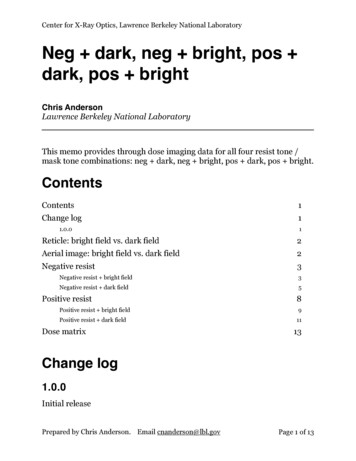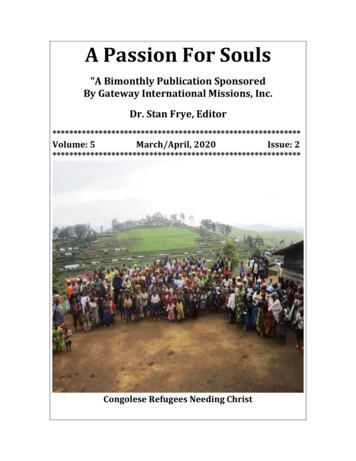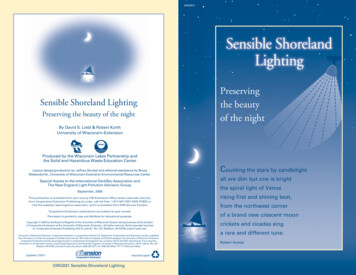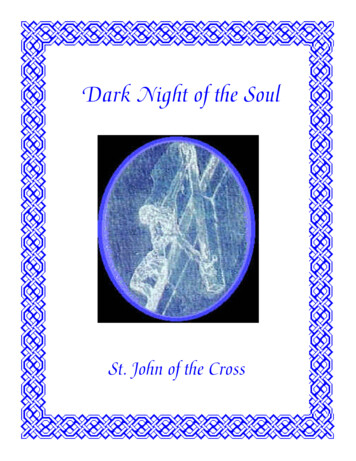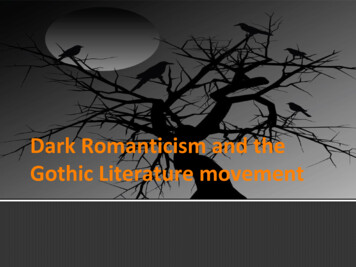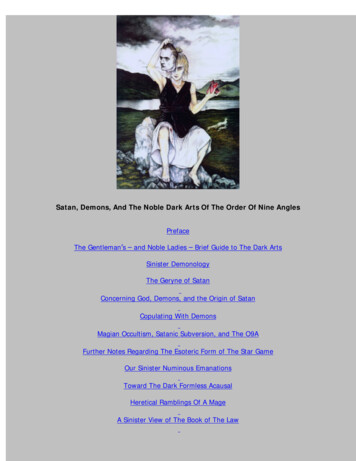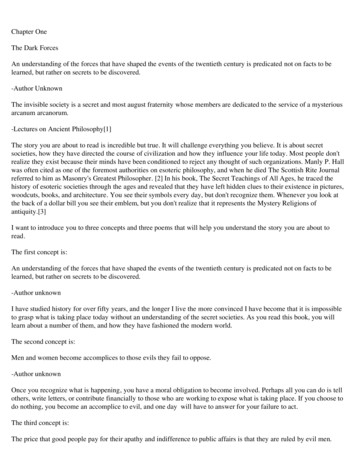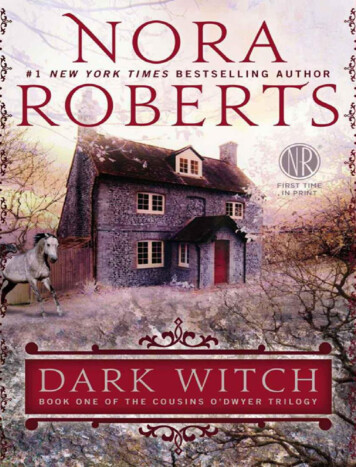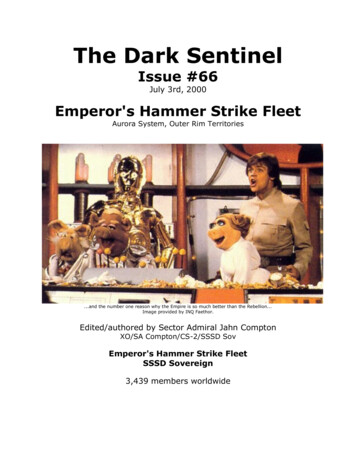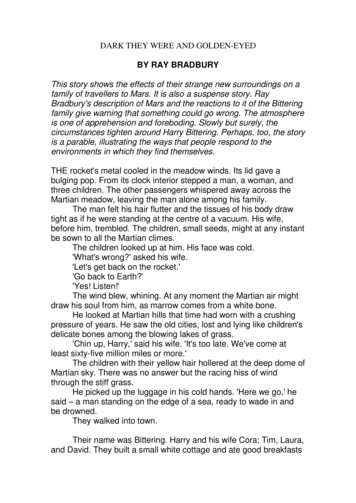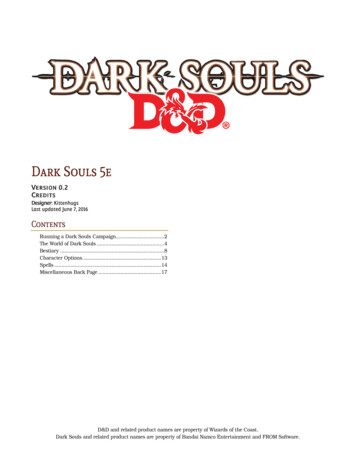
Transcription
Dark Souls 5eVERSION 0.2CREDITSDesigner: KittenhugsLast updated June 7, 2016ContentsRunning a Dark Souls Campaign.2The World of Dark Souls .4Bestiary .8Character Options.13Spells .14Miscellaneous Back Page .17D&D and related product names are property of Wizards of the Coast.Dark Souls and related product names are property of Bandai Namco Entertainment and FROM Software.
Running a Dark Souls CampaignDark Souls is a grim, dark (some may even say, grimdark)setting. Combat is lethal and the world is bleak. Capturingthis in a D&D 5e game takes a special approach.Player CharactersPlayer characters in a Dark Souls setting are likely to all bemembers of the cursed undead.Character CreationRunning a Dark Souls campaign demands severalconsiderations from the ground-up, starting withcharacter creation.Ability scores. Any form of ability score generation inthe Player’s Handbook can work well with a Dark Soulscampaign. However, realize that point buy can lead toirritating min-maxing, and rolling for stats can createcharacters that are exceptionally skilled in this grim,deadly world.Equipment. Standard equipment can make the earlygame a bit easier. You may consider only allowing a smallselection of items to start with. Try not to limit defensiveand offensive options too much. While Dark Souls issupposed to be difficult, purposely irritating your playerswon’t lead to a fun campaign.No matter how much extra wealth a character has atlevel 1, they cannot convert them to souls. Their wealth isactual gold and silver coins, worthless or not. If acharacter starting with 15 gp was allowed to convert thatgold to souls, the campaign would start with them at level3 before the game starts, avoiding the high lethality of thefirst two levels.Players and DeathThe cursed undead are immune to death. There will be norerolling characters here: death is a natural part of theDark Souls experience. Death happens to all undead atsome point or another, and can be of varying consequence.Losing money, souls, and equipment can be dire, but animportant addition to death is the consequences ofhollowing. Capturing how the descent into madnessaffects them is important for players to remember and forDMs to keep in mind. Rules for hollowing can be foundfurther in this document.The rules for the Darksign allow cursed undead tocome back to life at the bonfire they last rested at. Thiscan cause a party to split. It may be advisable to eitherdisallow the decision entirely or make it available as agroup decision.Level ProgressionUnlike normal D&D, leveling in Dark Souls is handled byspending souls. Souls can be lost upon death, becomingirretrievable in many cases. Leveling can be thus be quitea bit slower in a Dark Souls D&D campaign. This iscircumvented by giving souls as treasure in place of otherwealth. After all, in Dark Souls, experience and wealth areone and the same.Non-Human RacesDark Souls normally only features humans. Some DMsmay choose to simply limit player characters to humans.However, expanding your individual campaign’s lore toinclude how other races are affected by the spreading ofthe undead curse can add a level of intrigue beyond thestandard Dark Souls lore.Creating AdventuresEncounter BuildingDark Souls combat is brutal. Even the smallest creaturecan cause a quick death without proper care. As a DM,encounters should be usually built well into the “hard”threshold and beyond. Remember, death is a natural partof the Dark Souls experience.DifficultyMany D&D campaigns focus on a steady progressiontoward fighting stronger and stronger creatures. DarkSouls does, as well, but having extra options when thingsgo wrong is important. As a DM, you should focus onhaving three routes available whenever possible: an easyroute, where combat is survivable with relative ease; anormal route, the most obvious one where combat is fairlychallenging; and an advanced route, where combat’sdifficulty threshold is beyond what the player charactersare normally expected to manage.The EnvironmentEnvironmental hazards are also a big part of Souls games.Cliffs, pitfalls, poison swamps, fields of lava, spike-coveredrotating bridges—these are all well-featured in Dark Souls.Players should feel that the environment is actively tryingto harm them, like it’s an enemy of its own.TreasureIn Dark Souls, gold and silver pieces are worth about asmuch as a rock of the same size. They are usually nothingmore than oddities of a civilization that fell long ago.When you would give coins and gems as treasure,instead give souls. In the undead lands, creatures of allDark Souls 5e2
sorts hoard them for power or out of animalistic curiosity.1 copper piece is equivalent to 1 soul. Magic items andequipment can be found as normal.Variant RulesThis section contains optional rules that a DM can instatefor a more “Dark Souls” feel, especially in combat.Dodge RollWhen using this variant rule, player characters with 13 orhigher Dexterity automatically gain the Artful Dodger feat,detailed later in this document. A character who gains thefeat in such a way can only benefit from it if their speed isnot reduced due to encumbrance or from wearing armor.Poise and StaggerThis variant rule attempts to emulate Dark Souls’ staggerand poise mechanics.Poise. Each creature has an attribute called poise. Acreature’s poise score is equal to its Constitution modifier(minimum 1). A creature in light armor increases its poiseby 1, in medium armor increases its poise by 3, or inheavy armor increases its poise by 5. A creature wielding ashield increases its poise by 2. A Large or larger creatureincreases its poise by 5 for each size category it is aboveMedium. When not in armor, a monk gains extra poiseequal to his or her Wisdom modifier, and a barbarian gainsextra poise equal to his or her rage damage bonus.Stagger. When a creature is the target of an attack rollwith a result of 10 or higher, its poise decreases by 2,whether the attack hits or not. When a creature’s poise isless than 0, it is staggered. Attack rolls against a staggeredcreature are made with advantage, and a staggeredcreature has disadvantage on Dexterity saving throws. Acreature’s poise resets to its normal score at the beginningof its turn.Shield ParryThis variant rule gives Dark Souls’ shield parrying amechanical and flavorful effect.When a creature attacks a target wielding a shield andmisses, its attack is parried if its attack roll result wasequal to or greater than the target’s AC without the shield.In plainer terms, if the attack roll is equal to the target’sAC - 2 or AC - 1, it is parried. A creature who uses theability of the Defensive Duelist feat increases this range byan amount equal to its proficiency bonus.When its attack is parried, a creature can’t takeactions or reactions until the beginning of its next turn,and the first attack made against it is made withadvantage.Dark Souls 5e3
The World of Dark SoulsThis section contains rules and lore for playing andrunning a Dark Souls campaign.RestingThe End of an AgeThe world has turned and turned again, and the end ofthis age is nearing. For many years (how many none alivecan say), the spreading of an undead curse has wrackedcivilization. Most have already fallen. Those that haven’tsoon will.Cursed people are often locked away, out ofcivilization’s eyes. This works for a time. Eventually thenumber of cursed grows too large, hollows begin spreadingthroughout the land, and violence breaks out both fromand against them. Society becomes unstable, the noblesfind themselves penniless and the poor are left hopeless.Despair spreads across the land as the gods, once seemingso near, abandon the mortals of this world.It is not often that undead band together as you are.For survival, for glory, for rediscovering your past—nomatter the reason, you are gifted beyond other undead, ifonly slightly. Other undead have drawn to you, as you havedrawn to them. Perhaps you can survive in this world, andperhaps you are all destined for more? Is it possible thatyou can kindle the light of hope for this dying world?Life in a Dying WorldThis section describes specific aspects of a Dark Soulsstyle campaign world. Aspects outside of the curse’s effectsare often quite vague in Dark Souls’ lore. It is thus up tothe DM to fill these gaps as they will.BonfiresFlame, kindled by the souls of lords, sheds light in thisdarkening world. Bonfires serve as points of rest forwayward travelers.Fire KeepersBonfires are tended by Fire Keepers. These powerfulbeings feed the bonfires with souls and fuel for the sake oftravelers.Fire Keepers are almost always female humanoids andsuffer from some disability or disfigurement. Some aremute, some blind or deaf, some suffer from chronic illness,and so on. They are immune to the curse of the undeadand do not age so long as they stay at the bonfire.If a Fire Keeper is killed, her bonfire goes dark. It is nolonger a safe place to rest and can no longer be used as anormal bonfire can unless the Fire Keeper is restored tolife or another Fire Keeper takes her place.Bonfires are safe places where travelers can rest. Thosewho rest around them sleep soundly and feel strongermuch more quickly than usual. Dangerous hollows andmonsters are driven away by the light of its flames unlessthey are actively pursuing you. You can complete a long orshort rest at a bonfire in half the time it normally takes.If you have an estus flask, you can refill it at a bonfireby holding it into the flame for 1 minute. The fire does notburn you. Estus collects in the flask from the flames.The Cursed UndeadYou have been cursed with the wretched Darksign. Atattoo-like mark draws in souls from the environment,burning at its edges. You have become one of the manycursed undead.There is no cure for the Darksign. The might of clericsand gods have failed to cure it. Mighty mages havededicated their lives to its removal, all for naught. It haspersisted and spread through unknown means, appearingon humanoids and animals at random, as the worldbecomes filled with the ever-mad hollows.Despite being known as “cursed undead,” those cursedby the Darksign are not considered undead for thepurpose of effects that specify them.HollowingAs a cursed undead, you cannot truly die. When you die,you return to life 1d4 hours later, so long as your body ismostly intact. All your hit points are restored, butdiseases, poisons, and curses you were previously affectedby still persist as normal. When you rise after death, youcan choose to rise where you fell or at the last bonfire yourested at. If you choose to rise at a bonfire, your body andequipment vanish into ash and reappear around thebonfire.With each death a part of your old self is lost, and youslowly descend into madness, becoming a hollow, emptyshell. Your body also begins to decay, your flesh shrivelingand rotting the more you die. While your body is decayedas such, you have disadvantage on Charisma (Persuasion)checks and advantage on Charisma (Intimidation) checks.A decaying body does not age.When you rise after death, make a DC 10 Wisdomsaving throw. On a failed save, you gain one long-termmadness effect. When the effect would end, you mustrepeat the saving throw. On a failed save, it persists foranother 1d10 x 10 hours. If you fail the initial save by 5 ormore, you gain one indefinite madness effect. The DC forthis save increases by 1 each time you die. The tables forDark Souls 5e4
these effects can be found on page 260 of the DungeonMaster’s Guide.These madness effects are usually accompanied bysome memory loss. An important childhood memory mayno longer exist for you, save for an itching feeling of déjàvu. You may forget one of your closest friends or family, orhave their memory twisted into something terrible andtraumatic.In dire circumstances, you can sacrifice the souls youhold to return to a bonfire by touching your Darksign andconcentrating as an action. You and your equipment, butnot your collected souls, are transported back to thebonfire at which you last rested.The Power of SoulsYou can stave off hollowing by collecting souls. Each timea creature dies at your hand, either solely or in part, youabsorb some of their eternal essence through yourDarksign. As an undead, experience points (XP) you gainare instead collected as these souls. Some monsters mayalso drop larger souls they have collected, making theactual XP you gain from each creature more variable.At a bonfire, you can spend souls by feeding them toyour Darksign, staving off or reversing hollowing. Byspending 100 souls, you can end one long-term madnesseffect you gained from hollowing, or you can suppress oneindefinite madness effect for 24 hours. By spending 500souls, you can end one indefinite madness effect affectingyou, undo the rotting of your body from dying, or lower thesaving throw DC for your next hollowing by 1, to aminimum of 10.Souls can also be used to empower yourself, not justprevent the madness of your curse. At a bonfire, you canspend souls equal to the XP difference between yourcurrent and next level to gain a level.You can give souls to someone else like you would anitem, handing them over in various sizes of nearlyweightless balls of white smoke. In the lands of the cursedundead, souls serve as currency. The base “unit” of onesoul is equal to one copper coin. This also allows souls onyour person to be taken by other creatures, like any otheritem. If you are defeated by an enemy who knows of thepower of souls, dying will likely leave you soulless andpenniless.Magic and SpellcastingMagic was, in some places, treated as a high art in somecountries. Now, it has retreated once again to the realms ofthe ar
07.06.2016 · 1 copper piece is equivalent to 1 soul. Magic items and equipment can be found as normal. Variant Rules This section contains optional rules that a DM can instate for a more “Dark Souls” feel, especially in combat. Dodge Roll When using this variant rule, player characters with 13 or higher Dexterity automatically gain the Artful Dodger feat, detailed later in this document. A character .
